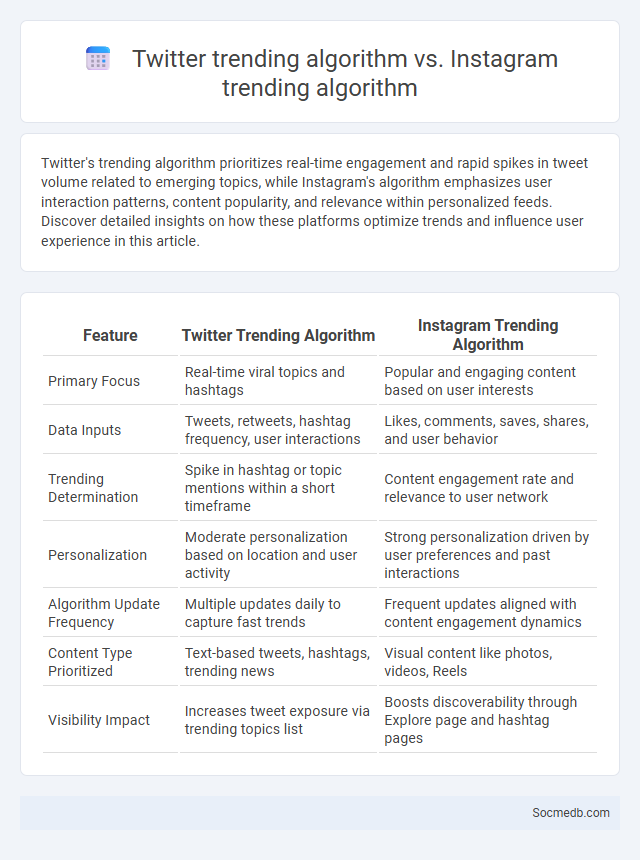
Photo illustration: Twitter trending algorithm vs Instagram trending algorithm
Twitter's trending algorithm prioritizes real-time engagement and rapid spikes in tweet volume related to emerging topics, while Instagram's algorithm emphasizes user interaction patterns, content popularity, and relevance within personalized feeds. Discover detailed insights on how these platforms optimize trends and influence user experience in this article.
Table of Comparison
| Feature | Twitter Trending Algorithm | Instagram Trending Algorithm |
|---|---|---|
| Primary Focus | Real-time viral topics and hashtags | Popular and engaging content based on user interests |
| Data Inputs | Tweets, retweets, hashtag frequency, user interactions | Likes, comments, saves, shares, and user behavior |
| Trending Determination | Spike in hashtag or topic mentions within a short timeframe | Content engagement rate and relevance to user network |
| Personalization | Moderate personalization based on location and user activity | Strong personalization driven by user preferences and past interactions |
| Algorithm Update Frequency | Multiple updates daily to capture fast trends | Frequent updates aligned with content engagement dynamics |
| Content Type Prioritized | Text-based tweets, hashtags, trending news | Visual content like photos, videos, Reels |
| Visibility Impact | Increases tweet exposure via trending topics list | Boosts discoverability through Explore page and hashtag pages |
Introduction to Social Media Trending Algorithms
Social media trending algorithms prioritize content based on user engagement metrics such as likes, shares, comments, and viewing time to maximize relevance and visibility. These algorithms analyze your behavior patterns, including interactions and preferences, to tailor the content feed specifically to your interests. Understanding how these systems work can help you optimize your posts for greater reach and influence in digital communities.
Overview of Twitter's Trending Algorithm
Twitter's trending algorithm identifies popular topics by analyzing the volume, velocity, and geographic location of tweets to surface relevant conversations in real-time. You can discover emerging discussions based on engagement metrics such as retweets, likes, and replies, which signal the significance of a topic. This dynamic system customizes Trends to your interests and location, ensuring your social media experience highlights the most pertinent and timely content.
Overview of Instagram's Trending Algorithm
Instagram's trending algorithm prioritizes content based on user engagement, relevance, and recency, ensuring popular posts gain maximum visibility. Your interactions, such as likes, comments, and shares, heavily influence the algorithm's ability to tailor your feed to trending topics. Machine learning techniques analyze patterns to surface content that resonates with widespread audience interests, making timely and engaging posts crucial for visibility.
Key Features of Twitter's Trend Detection
Twitter's trend detection leverages real-time data analysis, identifying sudden spikes in keyword usage across global and local contexts. Its algorithm prioritizes relevance, geographic location, and user engagement metrics to highlight emerging topics that matter most to Your network. The platform's ability to filter noise ensures only significant trends gain visibility, enhancing timely content discovery and audience interaction.
Key Features of Instagram's Trend Discovery
Instagram's trend discovery is powered by AI-driven algorithms that analyze user interactions to surface popular content tailored to individual preferences. The Explore tab leverages visual search and hashtag analytics to connect users with emerging trends across diverse niches. Real-time insights from Instagram Stories and Reels enhance trend visibility, enabling users to engage with viral topics and influencers effectively.
Comparative Analysis: Twitter vs Instagram Trends
Twitter excels in real-time information dissemination and trending topic detection, making it the preferred platform for news, politics, and public discourse. Instagram prioritizes visual content, fostering engagement through images and Stories, which appeals more to lifestyle, fashion, and influencer marketing sectors. User demographics differ significantly, with Twitter attracting a diverse age range interested in concise text updates, while Instagram's younger audience drives trends through creative visuals and interactive features.
Understanding Generic Trending Algorithms
Generic trending algorithms on social media analyze user interactions such as likes, shares, comments, and viewing duration to identify popular content rapidly. Machine learning models interpret these signals to amplify posts with high engagement probabilities, ensuring relevant and timely trends surface across diverse user feeds. Platforms continuously refine algorithms using real-time data to balance freshness, user preferences, and content diversity for optimized visibility.
Data Signals Influencing Social Media Trends
Data signals such as engagement metrics, user demographics, and content virality play a crucial role in shaping social media trends by influencing algorithmic recommendations and visibility. Platforms analyze interactions like likes, shares, comments, and viewing time to predict and promote trending topics that resonate with your interests. Real-time analytics and behavioral data empower social media networks to adapt content delivery dynamically, maximizing relevance and user retention.
Challenges and Criticisms of Trending Algorithms
Trending algorithms on social media platforms often prioritize sensational or viral content, which can lead to the spread of misinformation and polarizing views. These algorithms may create echo chambers by repeatedly showing users similar content, limiting your exposure to diverse perspectives. Privacy concerns also arise as data collection intensifies to optimize these algorithms, raising ethical questions about user consent and data security.
Future of Trending Algorithms in Social Media
Emerging trends in social media algorithms emphasize enhanced personalization through AI-driven content recommendations that adapt in real time to user behavior patterns. Future developments will likely integrate multi-modal data analysis, combining text, images, and videos to optimize engagement metrics and reduce misinformation spread. This evolution aims to create more dynamic, user-centric feeds that prioritize relevant, authentic, and context-aware content delivery.
 socmedb.com
socmedb.com